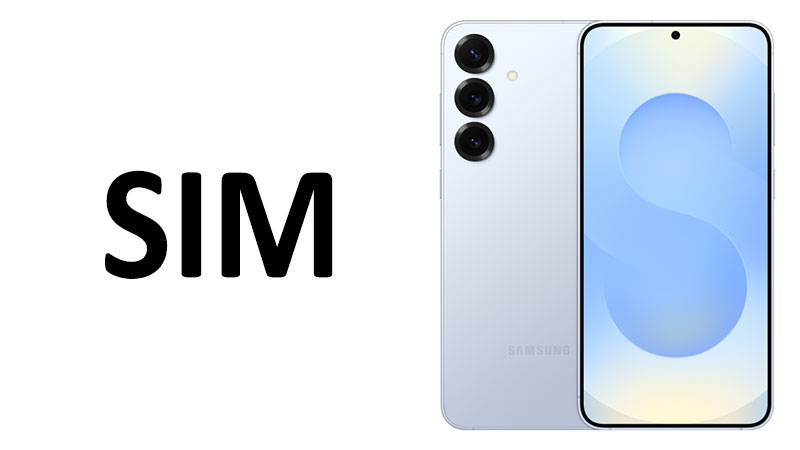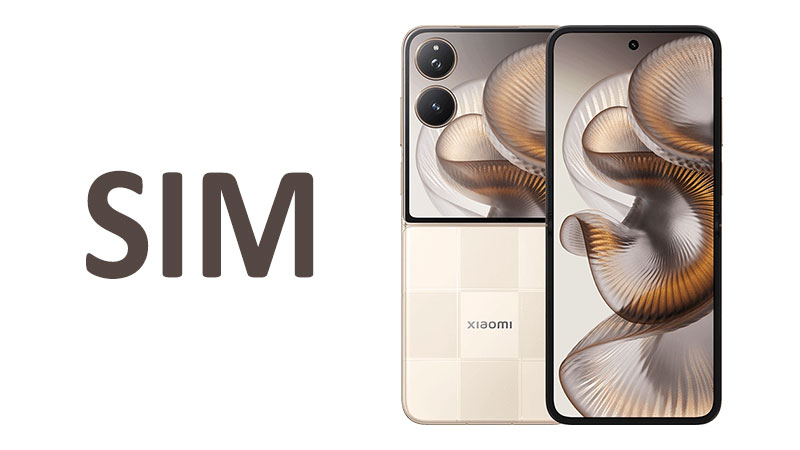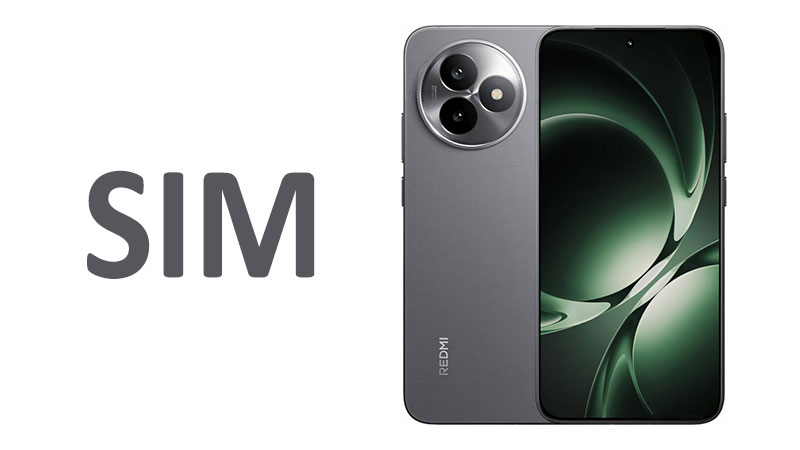The Samsung Galaxy S25 FE SIM setup is a crucial feature. It determines how users connect to the world. This article provides a comprehensive look at the phone’s robust connectivity suite. We will cover the flexible SIM options and the cutting-edge wireless standards. Understanding these details helps buyers make an informed choice. The Galaxy S25 FE is positioned as a powerful, value-driven device. Its network capabilities are central to its performance.
The Flexible SIM Strategy: Nano-SIM and eSIM Options
The Galaxy S25 FE offers highly versatile SIM configurations. This flexibility caters to various user needs globally. Buyers should pay close attention to the options available. The phone supports both physical Nano-SIM cards and modern embedded SIMs (eSIM).
Dual-SIM and eSIM Configurations Explained
The device supports four primary SIM combinations. These options ensure maximum adaptability for users.
- Nano-SIM: This is the traditional single physical SIM setup. It is straightforward and widely compatible with all carriers.
- Nano-SIM + Nano-SIM: This is a classic Dual-SIM configuration. It lets users manage two separate cellular lines simultaneously. This is ideal for balancing work and personal life. It is also perfect for international travelers.
- Nano-SIM + eSIM: This hybrid setup is becoming the new standard. It offers the best of both physical and digital SIMs. Users can use one physical card and one digital profile.
- eSIM + eSIM: This is the fully digital option. It allows the device to manage two embedded subscriber profiles. This configuration eliminates the need for any physical plastic cards.
Specialized Comparison: eSIM vs. Physical SIM
The inclusion of eSIM is a major advantage over older models. For instance, some previous Fan Edition phones offered less global eSIM support. The Galaxy S25 FE embraces this digital convenience fully.
eSIM technology provides instant activation. Users can switch carriers without visiting a store. This makes the phone highly desirable for frequent travelers. Physical Nano-SIMs, conversely, offer universal compatibility. They remain essential in regions where eSIM adoption is still low.
The dual-eSIM capability is especially noteworthy. It future-proofs the device for a digital-first mobile world.
Pros and Cons of the SIM Setup
The versatile SIM setup brings significant benefits. However, it also presents a few minor challenges.
Pros:
- Ultimate Flexibility: The four options cover every possible user scenario.
- eSIM Convenience: Digital SIMs simplify travel and carrier switching.
- Dual-SIM Functionality: Users can easily keep two numbers active at once.
- Enhanced Security: eSIMs cannot be physically removed, offering theft protection.
Cons:
- Market Dependency: The dual Nano-SIM option might be limited in certain regions.
- eSIM Adoption: Some smaller international carriers still do not support eSIM fully.
- Setup Complexity: Activating the first eSIM may be slightly less intuitive for new users.
Advanced Network Connectivity: 5G, LTE, and Global Standards
The cellular network technology dictates speed and coverage. The Galaxy S25 FE uses a comprehensive range of standards. This ensures high-speed connectivity across the globe.
Technology Overview: GSM / HSPA / LTE / 5G
The phone supports all major generational standards.
- GSM (2G): Provides basic voice calls and low-speed data. It serves as a necessary fallback in remote areas.
- HSPA (3G): Offers faster data speeds than 2G. This is an older standard but is still relevant in developing markets.
- LTE (4G): This is the current widespread high-speed data standard. It enables fast downloads, streaming, and HD video calls. LTE remains the backbone of most cellular networks.
- 5G (Fifth Generation): This is the star feature for modern speed. It provides ultra-low latency and incredibly fast data rates. The S25 FE ensures access to the fastest mobile networks available.
The Power of 5G Connectivity
5G is the key driver of this generation’s connectivity. The Galaxy S25 FE’s 5G capability is robust and reliable. It supports both Sub-6GHz and potentially mmWave networks. Sub-6GHz provides wide coverage and good speed indoors. MmWave offers blistering speeds but over shorter distances.
For a mid-premium device, strong 5G support is essential. It delivers the speed required for cloud gaming and high-resolution streaming. Compared to budget 5G phones, the S25 FE often includes more 5G bands. This offers superior roaming and better future-proofing.
Wi-Fi 6e: Stepping into the 6 GHz Band
The Wi-Fi capabilities of the S25 FE are top-tier. The inclusion of Wi-Fi 6e is a significant upgrade. It leverages the newly opened 6 GHz frequency band.
Understanding Wi-Fi 6e
Wi-Fi 6e is an extension of the Wi-Fi 6 standard. It adds the dedicated 6 GHz band to the existing 2.4 GHz and 5 GHz bands. This makes the phone a true tri-band capable device.
- 2.4 GHz: This band offers the widest range and best wall penetration. However, its speeds are the slowest.
- 5 GHz: This band offers faster speeds than 2.4 GHz. Its range is more limited.
- 6 GHz: This new band provides the fastest possible local wireless speeds. It is also much less congested than the 2.4 GHz and 5 GHz bands. This translates directly to ultra-low latency and greater stability.
The S25 FE may be marketed with dual-band or tri-band Wi-Fi. This distinction depends heavily on the specific market or region. Buyers should check local specifications carefully.
Wi-Fi 6e Pros and Cons
The benefits of Wi-Fi 6e are especially noticeable in crowded environments.
Pros:
- Reduced Interference: The 6 GHz band is essentially a clear, new wireless highway. It avoids congestion from older Wi-Fi devices and appliances.
- Higher Throughput: The phone can achieve multi-gigabit speeds when connected to a Wi-Fi 6e router. This is great for large file transfers.
- Lower Latency: Improved latency is a major benefit for competitive mobile gamers.
- Future-Proofing: It ensures the phone stays relevant with modern networking hardware.
Cons:
- Router Requirement: Users must own a Wi-Fi 6e compatible router to utilize the 6 GHz band.
- Shorter Range: The high-frequency 6 GHz signal does not penetrate walls as well as 2.4 GHz. Speed drops quickly as distance increases.
Wi-Fi Direct
The phone also supports Wi-Fi Direct. This technology allows devices to connect directly to each other. It bypasses the need for a traditional Wi-Fi router. This is useful for file sharing and screen mirroring.
Bluetooth 5.4: Smarter, Faster, and More Efficient
The Galaxy S25 FE features the latest Bluetooth 5.4 standard. Bluetooth connectivity is vital for wireless accessories. This includes headphones, smartwatches, and car systems.
Key Enhancements in Bluetooth 5.4
Bluetooth 5.4 brings key improvements over the older 5.3 and 5.2 versions. The focus is on efficiency and expanded capabilities.
- Enhanced Power Efficiency (LE): The Low Energy (LE) standard is further optimized. This means longer battery life for connected accessories. It also extends the phone’s overall battery runtime.
- Improved Security: Bluetooth 5.4 includes stronger security protocols. This helps keep wireless connections safer from unauthorized access.
- Better Data Transmission: It supports higher data transmission without requiring a direct, constant link. This is great for smart home sensor networks.
- Periodic Advertising with Responses (PAwR): This feature allows the phone to manage large networks of small, simple devices. This is important for a growing IoT (Internet of Things) ecosystem.
Real-World Impact
For the average user, Bluetooth 5.4 means a few key things. They will experience more reliable connections with TWS earbuds. Audio quality is more stable. The pairing process can feel faster and more seamless. The improved energy management is a silent benefit. It reduces the drain on the phone when many devices are linked.
In comparison, the previous Galaxy S24 FE likely used an older standard like Bluetooth 5.3 or 5.2. The jump to 5.4 ensures the S25 FE remains current with the latest wearable technology.
Universal Connectivity: Positioning, NFC, and USB Standard
Beyond core cellular and Wi-Fi, the S25 FE integrates key universal connectivity features. These standards are essential for daily function.
Multi-Constellation Positioning
Accurate location tracking is crucial for navigation and geo-tagging. The Galaxy S25 FE supports four major global navigation satellite systems (GNSS).
- GPS (USA): The original and most common system.
- GLONASS (Russia): Provides additional satellite coverage for better accuracy.
- GALILEO (Europe): Offers highly precise positioning and reliability.
- BDS (BeiDou, China): Further increases the number of available satellites.
The use of multiple constellations (multi-GNSS) is standard in premium phones. It improves the speed of satellite lock-on. It also ensures greater positional accuracy in challenging environments. This includes dense city centers and mountainous regions.
NFC: Contactless Convenience
The inclusion of NFC (Near Field Communication) is standard. NFC enables fast, short-range wireless communication.
Its primary function is supporting mobile payments. This is done through services like Samsung Wallet and Google Pay. NFC also facilitates quick pairing with accessories. It can also be used to read smart tags and transit cards. For daily convenience, NFC is a must-have feature.
USB Type-C 3.2: High-Speed Wired Performance
The wired connection on the S25 FE is powerful. It features a USB Type-C 3.2 port with OTG support. This choice of standard is a significant performance indicator.
USB 3.2 vs. USB 2.0:
Many mid-range phones still use the older USB 2.0 standard. USB 2.0 has a maximum theoretical transfer speed of 480 Mbps. The USB Type-C 3.2 standard, however, can support up to 20 Gbps. This is a massive difference in wired data transfer speed.
- Data Transfer: Transferring large video files or photo libraries becomes much faster. Moving 10 GB of data could take minutes on USB 2.0. It will take only seconds using a compatible USB 3.2 cable.
- OTG Support: OTG (On-The-Go) allows the phone to act as a host. Users can connect external devices like flash drives, keyboards, and mice directly. This enhances the phone’s productivity capabilities.
- Wired Charging: The Type-C port supports high-speed charging protocols. While the standard dictates data speed, the port itself handles the phone’s fast-charging capability.
The inclusion of USB 3.2 aligns the S25 FE with flagship standards. It avoids the data transfer bottleneck found in many competitors.
Important Points for Buyers and Readers
Anyone considering the Samsung Galaxy S25 FE must understand these points. The connectivity features impact daily use.
Future-Proofing
The S25 FE incorporates modern standards across the board. The 5G, Wi-Fi 6e, Bluetooth 5.4, and USB 3.2 features are current technology. They ensure the phone will remain relevant for many years. Buyers will not feel forced to upgrade soon due to outdated wireless tech. Samsung supports this device for a long period of time.
Regional Variations
Potential buyers must confirm local specifications. The tri-band Wi-Fi capability is dependent on the region. Availability of the dual Nano-SIM tray also varies by market. Always check the model number specific to your country or carrier.
Accessory Compatibility
To fully exploit the features, users need compatible accessories.
- For 5G: A 5G plan and living in a 5G coverage area is necessary.
- For Wi-Fi 6e: A Wi-Fi 6e router is required for the fastest speeds.
- For USB 3.2: A proper USB 3.2 Gen 2 cable is needed to achieve high transfer rates. Older USB 2.0 cables will limit the speed significantly.
The phone provides the hardware. Users must supply the necessary environment and peripherals.
Specialized Connectivity Comparison: S25 FE vs. Predecessor
It is useful to compare the S25 FE against the Galaxy S24 FE. These comparisons highlight the progress Samsung has made.
The S24 FE typically offered strong LTE and 5G. It often featured Wi-Fi 6, but not the extended 6 GHz band. The upgrade to Wi-Fi 6e on the S25 FE offers a new level of local network speed. This is the most substantial wireless upgrade.
Furthermore, the Bluetooth version has likely advanced. The S25 FE’s Bluetooth 5.4 improves efficiency and security over earlier versions. The USB standard also sees a potential jump. If the S24 FE used USB 2.0, the S25 FE’s USB 3.2 offers a twenty-fold increase in data transfer speed. This speed difference affects content creators greatly.
Overall, the S25 FE brings key internal connectivity features up to flagship standards. This makes it a stronger long-term investment.
Pros and Cons Summary: Connectivity Suite
Here is a final summary of the connectivity suite’s strengths and weaknesses.
Strengths:
- SIM Versatility: Supports all four configurations, including dual eSIM.
- Modern Wi-Fi: Wi-Fi 6e capability ensures a clear, fast connection.
- High-Speed USB: USB Type-C 3.2 provides rapid wired data transfers.
- Advanced Bluetooth: Version 5.4 improves accessory battery life and security.
- Global GNSS: Multi-system positioning offers superior location accuracy.
Weaknesses:
- Tri-Band Variability: The tri-band Wi-Fi availability is not universal. It depends on the sales region.
- New Standard Dependency: Full performance requires updated user equipment. This means a Wi-Fi 6e router and USB 3.2 cable.
- Carrier Support: eSIM functionality still relies on the user’s mobile carrier.
Conclusion: Making an Informed Connectivity Choice
The Samsung Galaxy S25 FE SIM and connectivity features are exceptional. They define it as a true mid-premium smartphone. The device’s flexibility in SIM management is outstanding. Users gain convenience through the multiple eSIM and Nano-SIM options.
The wireless ecosystem is highly advanced. Wi-Fi 6e delivers blazing-fast local network performance. Bluetooth 5.4 ensures an efficient accessory experience. The inclusion of high-speed USB Type-C 3.2 is a major win. It eliminates a common bottleneck found in competitors.
Overall, the Galaxy S25 FE is highly future-proofed in terms of connectivity. Buyers can be confident that the device will support the fastest networks. It will also work with the next generation of wireless accessories. The S25 FE offers a robust and comprehensive connection profile. This makes it an excellent choice for demanding users and global travelers.
Frequently Asked Questions (FAQ)
1. Does the Samsung Galaxy S25 FE support two physical SIM cards? Yes, in some regions, it supports a Dual-SIM setup. This allows for two physical Nano-SIM cards. Check your local carrier version for confirmation.
2. Is eSIM functionality available on the Galaxy S25 FE? Yes, the phone supports eSIM technology. It can run as a hybrid (Nano-SIM + eSIM) or a fully digital device (eSIM + eSIM).
3. What is the benefit of Wi-Fi 6e on this phone? Wi-Fi 6e uses a new 6 GHz band. This new band provides faster speeds and much less interference. It greatly improves performance in congested Wi-Fi areas.
4. How fast is data transfer using the USB Type-C 3.2 port? The USB Type-C 3.2 standard allows for theoretical data transfer speeds up to 20 Gbps. This is significantly faster than the 480 Mbps of older USB 2.0 ports.
5. Does the phone support 5G globally? The phone supports GSM, HSPA, LTE, and 5G network technologies. It is built to connect to 5G networks internationally. Actual coverage depends on the local network bands and the user’s carrier plan.



